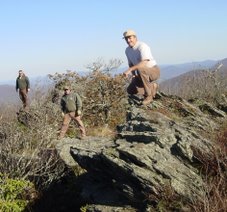Here is an opening that we created a couple years ago on dry rocky ridge. Our first planting on this site was a fall planting of wheat and ladino clover which did OK through the fall, but mostly died out through the winter and never recovered as the site dried out the following spring. So we opted to replant to a mixture of sweetclover, timothy, and chickory on this site because these plants were the most likely to survive and produce forage for wildlife. This planting grew and established a fair stand despite extreme drought conditions during the 2008 growing season. Now in it's second season, this planting has received some good rains and is producing well.


The sweetclover is the taller plant with yellow flowers, chickory is the lower growing forb that looks kind of like a dandelion, and timothy is the grass with a compact, fine seedhead. All three can be seen in the photo above.

Look closely at the photo above and you can see that this sweetclover plant has been heavily browsed by deer, and judging from the trails and tracks, this plot has become a favored feeding area for many deer. I munched on a bit of the sweetclover myself and found it to be more palatable than most field forage crops, a bit of leaves in your salad would probably give it a slightly bitter, lemon-peppery taste. The field is also abuzz with thousands of bees and other insects attracted to the blossoms of the sweetclover, which in turn brings turkeys and grouse whose young depend on insects for a large part of their diet. Here is another view of this opening with plenty of blueberries and chinkapins in the foreground, the presence of these valuable mast producing shrubs is a direct result of our very effective prescribed burning program. You can also see some dead trees in the background resulting from a burn we conducted here two years ago.

Check out the bumper crop of blueberries (or huckleberries? can anybody tell me the difference?) we have on this site.

The soil on this site is quite acidic, as they are in almost all of our work area, blueberries love it, but sweetclover does not do well in acidic soils. We applied a good dose of pulverized limestone when we planted and after testing the soil, decided to apply another dose of lime recently(see below.)





